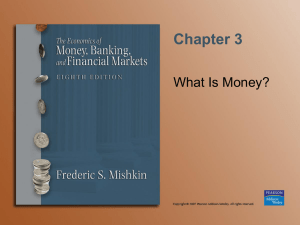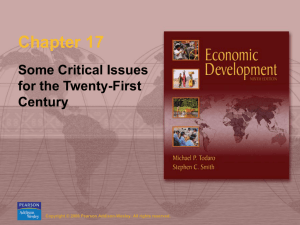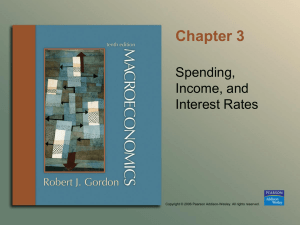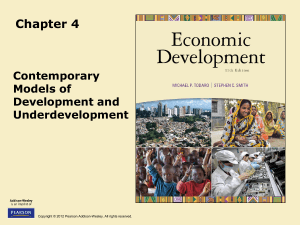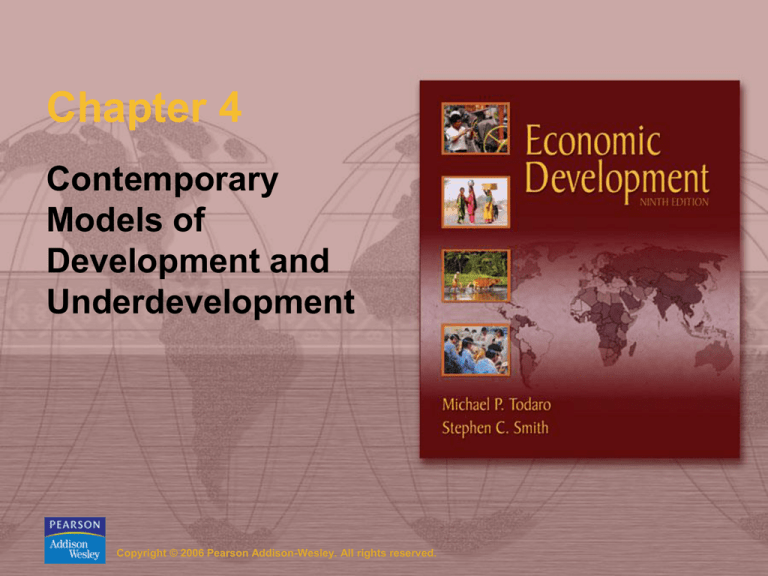
Chapter 4
Contemporary
Models of
Development and
Underdevelopment
Copyright © 2006 Pearson Addison-Wesley. All rights reserved.
New Growth Theory: Endogenous
Growth
Motivation for the new growth theory
– Technological Progress as an exogenous factor
– i.e. main cause of growth goes unexplained
The Romer model (Paul Romer, 1986, a
Ph.D. thesis offshoot)
Copyright © 2006 Pearson Addison-Wesley. All rights reserved.
4-2
New Growth Theory: Endogenous
Growth
The Romer model
Idea: Capital includes knowledge capital, some of
which – in principle - has a public good character
and will diffuse in technology spillovers
Consequence: an increase in the average capital
stock of all sectors of an economy increases the
productivity of each sector
Increasing returns to scale at an aggregate level
Copyright © 2006 Pearson Addison-Wesley. All rights reserved.
4-3
New Growth Theory: Endogenous
Growth
The Romer model
1
Yi AKi Li K
Y AK
1
L
n
g n
1
Copyright © 2006 Pearson Addison-Wesley. All rights reserved.
(4.1)
(4.2)
(4.3)
4-4
New Growth Theory
Criticisms:
– Still relies on many „perfectness“ assumptions
and simplifications not relevant for developing
countries
Copyright © 2006 Pearson Addison-Wesley. All rights reserved.
4-5
Underdevelopment as a
Coordination Failure
Coordination failures occur when agents’
inability to coordinate their actions leads to
an outcome that makes all agents worse off
We’ll consider
– “Big push” models
– The ‘O-ring’ model
The “meeting-in-a-restaurant-problem” as a
generic example
Copyright © 2006 Pearson Addison-Wesley. All rights reserved.
4-6
Coordination failures: examples
Complementary investments
– R&D spillovers
– Network of firms
– Human capital and firms demanding it
Complementary specialization
– From subsistence to market agriculture
A role for a “big player” able to commit
Copyright © 2006 Pearson Addison-Wesley. All rights reserved.
4-7
Multiple Equilibria: A
Diagrammatic Approach
Generally, these models can be
diagrammed by graphing an S-shaped
function and the 45º line
Equilibria are
– Stable when the function crosses the 45º line
from above
– Unstable when the function crosses the 45º line
from below
Copyright © 2006 Pearson Addison-Wesley. All rights reserved.
4-8
Figure 4.1
Copyright © 2006 Pearson Addison-Wesley. All rights reserved.
4-9
Starting Economic Development:
The Big Push
Sometimes market failures lead to an a
priori role for public policy intervention
The general intuition
– A firm creating demand by paying (high) wages
is only receiving a small part of this demand as
demand for its own products
– Moods, expectations or government incentives
or demand may be necessary!
Copyright © 2006 Pearson Addison-Wesley. All rights reserved.
4-10
Starting Economic Development:
The Big Push: Assumptions
Assumptions of this specific model
Perfect competition in traditional sector, natural monopolies
(increasing returns!) in the modern sector
Only labor as a factor, in trad. Sector, one worker produces
one unit of output
w = 1 in traditional sector w > 1 in modern sector
Increasing returns modeled through to minimal worker
requirement F
Each good is receiving a constant share of demand
P = 1 in both sectors (entry deterrence!)
Copyright © 2006 Pearson Addison-Wesley. All rights reserved.
4-11
Graphical Analysis
Copyright © 2006 Pearson Addison-Wesley. All rights reserved.
4-12
Other Cases in Which a Big Push
May Be Necessary
Intertemporal effects: intertemporal demand
externality
Urbanization effects: if demand for modern
sector goods is primarily urban
Infrastructure effects,Training effects: joint
use of intermediate input
Copyright © 2006 Pearson Addison-Wesley. All rights reserved.
4-13
Why the problem cannot be
solved by a “super-entrepreneur”
Imperfect capital market
Too large agency costs (monitoring,
inefficiencies) in the super-firm
Inefficient competition for the role of superentrepreneur
Copyright © 2006 Pearson Addison-Wesley. All rights reserved.
4-14
Further Problems of Multiple
Equilibria
Inefficient advantages of incumbency: Getting
stuck with an outmoded technology of a
monopolist
Behavior and norms: Being good pays if
everybody is good
Inequality, multiple equilibria, and growth
– High inequality harms especially through imperfect
credit markets (entrepreneurship, education)
Linkages as a tool to target government
intervention
– Backward, forward, final-demand
Copyright © 2006 Pearson Addison-Wesley. All rights reserved.
4-15
Kremer’s O-Ring Theory of
Economic Development
Ideas: Quality of production is determined
by highly complementary tasks: The
weakest link determines quality!
Workers of different quality are not
substitutable
Central result: Assortative matching of
workers to firms
May also apply across firms!
Copyright © 2006 Pearson Addison-Wesley. All rights reserved.
4-16
Implications of the O-ring theory
Investment of any one in skills may be
dependent on investment of all
High income and low income clusters
(nations, regions, ...)
Extreme income differences between
clusters
Brain-Drain!
Copyright © 2006 Pearson Addison-Wesley. All rights reserved.
4-17
Figure 4.3
Copyright © 2006 Pearson Addison-Wesley. All rights reserved.
4-18
Concepts for Review
Agency costs
Agent
Aid failure
Asymmetric
information
Big push
Complementarities
Complementary
investments
Copyright © 2006 Pearson Addison-Wesley. All rights reserved.
Congestion
Coordination failure
Deep intervention
Endogenous growth
theory
Linkage
Multiple equilibria
New growth theory
O-ring model
4-19
Concepts for Review (cont’d)
O-ring production
function
Pareto improvement
Pecuniary externalities
Poverty trap
Prisoners’ dilemma
Public good
Copyright © 2006 Pearson Addison-Wesley. All rights reserved.
Romer’s endogenous
growth model
Solow residual
Technological
externalities
Underdevelopment
trap
Where-to-meet
dilemma
4-20

